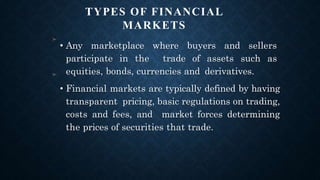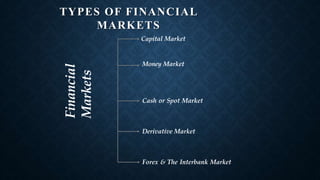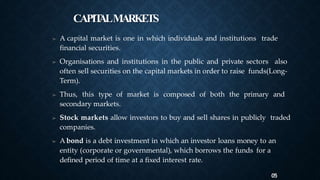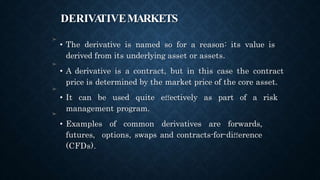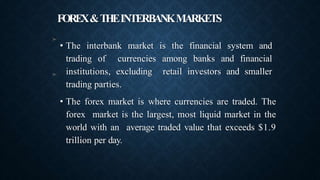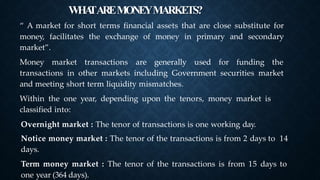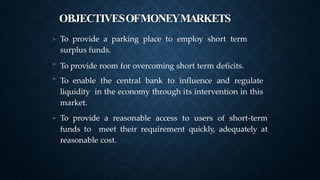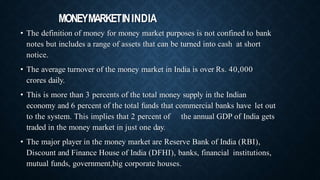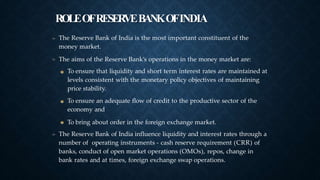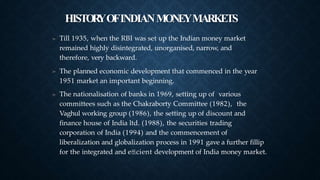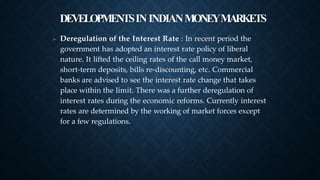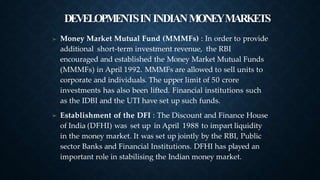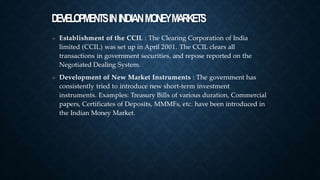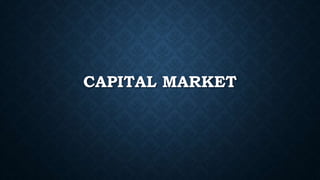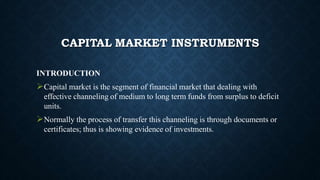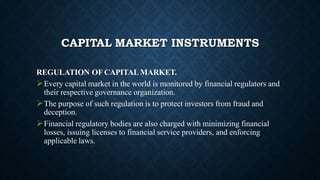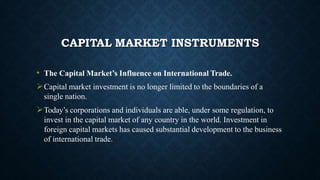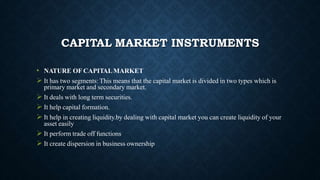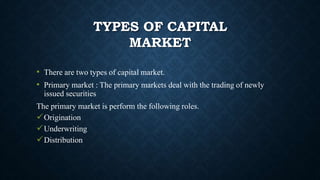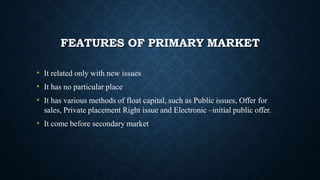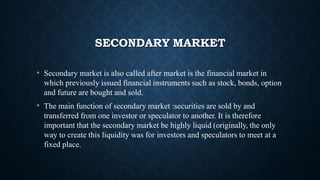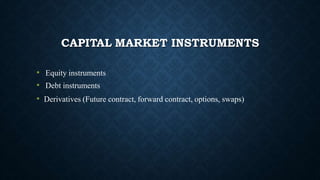Money market and capital market in india.pptx
- 1. MONEY MARKET AND CAPITAL MARKET IN INDIA
- 2. TYPES OF FINANCIAL MARKETS ➤ • Any marketplace where buyers and sellers participate in the trade of assets such as equities, bonds, currencies and derivatives. • Financial markets are typically defined by having transparent pricing, basic regulations on trading, costs and fees, and market forces determining the prices of securities that trade. ➤
- 3. TYPES OF FINANCIAL MARKETS Financial Markets Capital Market Money Market Cash or Spot Market Derivative Market Forex & The Interbank Market
- 4. CAPIT ALMARKETS ➤ A capital market is one in which individuals and institutions trade financial securities. Organisations and institutions in the public and private sectors also often sell securities on the capital markets in order to raise funds(Long- Term). Thus, this type of market is composed of both the primary and secondary markets. Stock markets allow investors to buy and sell shares in publicly traded companies. A bond is a debt investment in which an investor loans money to an entity (corporate or governmental), which borrows the funds for a defined period of time at a fixed interest rate. ➤ ➤ ➤ ➤ 05
- 5. CASHORSPOTMARKETS ➤ Investing in the cash or "spot" market is highly sophisticated, with opportunities for both big losses and big gains. In the cash market, goods are sold for cash and are delivered immediately. Prices are settled in cash "on the spot" at current market prices. This is notably different from other markets, in which trades are determined at forward prices. Dominated by institutional market players such as hedge funds, limited partnerships and corporate investors. ➤ ➤ ➤
- 6. DERIVA TIVEMARKETS ➤ • The derivative is named so for a reason: its value is derived from its underlying asset or assets. • A derivative is a contract, but in this case the contract price is determined by the market price of the core asset. • It can be used quite effectively as part of a risk management program. • Examples of common derivatives are forwards, futures, options, swaps and contracts-for-difference (CFDs). ➤ ➤ ➤
- 7. FOREX&THEINTERBANKMARKETS ➤ • The interbank market is the financial system and trading of currencies among banks and financial institutions, excluding retail investors and smaller trading parties. • The forex market is where currencies are traded. The forex market is the largest, most liquid market in the world with an average traded value that exceeds $1.9 trillion per day. ➤
- 8. WHA TAREMONEYMARKETS? ➤ “ A market for short terms financial assets that are close substitute for money, facilitates the exchange of money in primary and secondary market”. Money market transactions are generally used for funding the transactions in other markets including Government securities market and meeting short term liquidity mismatches. Within the one year, depending upon the tenors, money market is classified into: Overnight market : The tenor of transactions is one working day. Notice money market : The tenor of the transactions is from 2 days to 14 days. Term money market : The tenor of the transactions is from 15 days to one year (364 days).
- 9. STRUCTUREOFMONEYMARKETSININDIA Indian Money Market Sub Markets Organised Reserve bank of India Schedule Commercial Banks Lenders Development Banks Investment Institutions Regional Rural Banks Foreign Banks State Financial Corp. Discounted & Finance House of India Unorganised Indigenous Bankers Domestic Money Nidhis & Chit Funds Traders & Friends Brokers & Dealers Call Money Market Bill Market 364 day Bill Market Certificate of Deposit Commercial Paper’s Commercial Bills T reasuryBills
- 10. OBJECTIVESOFMONEYMARKETS ➤ To provide a parking place to employ short term surplus funds. To provide room for overcoming short term deficits. To enable the central bank to influence and regulate liquidity in the economy through its intervention in this market. To provide a reasonable access to users of short-term funds to meet their requirement quickly, adequately at reasonable cost. ➤ ➤ ➤
- 11. MONEYMARKETININDIA • The definition of money for money market purposes is not confined to bank notes but includes a range of assets that can be turned into cash at short notice. • The average turnover of the money market in India is over Rs. 40,000 crores daily. • This is more than 3 percents of the total money supply in the Indian economy and 6 percent of the total funds that commercial banks have let out to the system. This implies that 2 percent of the annual GDP of India gets traded in the money market in just one day. • The major player in the money market are Reserve Bank of India (RBI), Discount and Finance House of India (DFHI), banks, financial institutions, mutual funds, government,big corporate houses.
- 12. FEA TURESOFINDIANMONEYMARKETS ➤ Existence of Unorganised Money Market. Absence of Integration Diversity in Money Rates of Interest Seasonal Market Highly volatile call money market Absence of a well organised Banking System Availability of credit instruments ➤ ➤ ➤ ➤ ➤ ➤
- 13. ROLEOFRESERVEBANKOFINDIA ➤ ➤ The Reserve Bank of India is the most important constituent of the money market. The aims of the Reserve Bank’s operations in the money market are: To ensure that liquidity and short term interest rates are maintained at levels consistent with the monetary policy objectives of maintaining price stability. To ensure an adequate flow of credit to the productive sector of the economy and To bring about order in the foreign exchange market. The Reserve Bank of India influence liquidity and interest rates through a number of operating instruments - cash reserve requirement (CRR) of banks, conduct of open market operations (OMOs), repos, change in bank rates and at times, foreign exchange swap operations. ➤
- 14. HISTOR YOFINDIANMONEYMARKETS ➤ Till 1935, when the RBI was set up the Indian money market remained highly disintegrated, unorganised, narrow, and therefore, very backward. The planned economic development that commenced in the year 1951 market an important beginning. The nationalisation of banks in 1969, setting up of various committees such as the Chakraborty Committee (1982), the Vaghul working group (1986), the setting up of discount and finance house of India ltd. (1988), the securities trading corporation of India (1994) and the commencement of liberalization and globalization process in 1991 gave a further fillip for the integrated and efficient development of India money market. ➤ ➤
- 15. DEVELOPMENTSININDIANMONEYMARKETS ➤ Deregulation of the Interest Rate : In recent period the government has adopted an interest rate policy of liberal nature. It lifted the ceiling rates of the call money market, short-term deposits, bills re-discounting, etc. Commercial banks are advised to see the interest rate change that takes place within the limit. There was a further deregulation of interest rates during the economic reforms. Currently interest rates are determined by the working of market forces except for a few regulations.
- 16. DEVELOPMENTSININDIANMONEYMARKETS ➤ Money Market Mutual Fund (MMMFs) : In order to provide additional short-term investment revenue, the RBI encouraged and established the Money Market Mutual Funds (MMMFs) in April 1992. MMMFs are allowed to sell units to corporate and individuals. The upper limit of 50 crore investments has also been lifted. Financial institutions such as the IDBI and the UTI have set up such funds. Establishment of the DFI : The Discount and Finance House of India (DFHI) was set up in April 1988 to impart liquidity in the money market. It was set up jointly by the RBI, Public sector Banks and Financial Institutions. DFHI has played an important role in stabilising the Indian money market. ➤
- 17. DEVELOPMENTSININDIANMONEYMARKETS ➤ Establishment of the CCIL : The Clearing Corporation of India limited (CCIL) was set up in April 2001. The CCIL clears all transactions in government securities, and repose reported on the Negotiated Dealing System. Development of New Market Instruments : The government has consistently tried to introduce new short-term investment instruments. Examples: Treasury Bills of various duration, Commercial papers, Certificates of Deposits, MMMFs, etc. have been introduced in the Indian Money Market. ➤
- 18. CAPITAL MARKET
- 19. CAPITAL MARKET INSTRUMENTS INTRODUCTION Capital market is the segment of financial market that dealing with effective channeling of medium to long term funds from surplus to deficit units. Normally the process of transfer this channeling is through documents or certificates; thus is showing evidence of investments.
- 20. CAPITAL MARKET INSTRUMENTS PRIMARY ROLE The primary roles of capital market is to raise long term funds for government, banks, and corporation while providing platform for the trading of securities. This fund raising is regulated by the performance of stocks and bonds market within the capital market The member or organizations of the capital market may issue stocks and bonds in order to raise funds. Investors can then invest in the capital market by purchasing those stocks and bonds
- 21. CAPITAL MARKET INSTRUMENTS REGULATION OF CAPITAL MARKET. Every capital market in the world is monitored by financial regulators and their respective governance organization. The purpose of such regulation is to protect investors from fraud and deception. Financial regulatory bodies are also charged with minimizing financial losses, issuing licenses to financial service providers, and enforcing applicable laws.
- 22. CAPITAL MARKET INSTRUMENTS • The Capital Market’s Influence on International Trade. Capital market investment is no longer limited to the boundaries of a single nation. Today’s corporations and individuals are able, under some regulation, to invest in the capital market of any country in the world. Investment in foreign capital markets has caused substantial development to the business of international trade.
- 23. CAPITAL MARKET INSTRUMENTS • NATURE OF CAPITALMARKET It has two segments: This means that the capital market is divided in two types which is primary market and secondary market. It deals with long term securities. It help capital formation. It help in creating liquidity.by dealing with capital market you can create liquidity of your asset easily It perform trade off functions It create dispersion in business ownership
- 24. TYPES OF CAPITAL MARKET • There are two types of capital market. • Primary market : The primary markets deal with the trading of newly issued securities The primary market is perform the following roles. Origination Underwriting Distribution
- 25. FEATURES OF PRIMARY MARKET • It related only with new issues • It has no particular place • It has various methods of float capital, such as Public issues, Offer for sales, Private placement Right issue and Electronic –initial public offer. • It come before secondary market
- 26. SECONDARY MARKET • Secondary market is also called after market is the financial market in which previously issued financial instruments such as stock, bonds, option and future are bought and sold. • The main function of secondary market :securities are sold by and transferred from one investor or speculator to another. It is therefore important that the secondary market be highly liquid (originally, the only way to create this liquidity was for investors and speculators to meet at a fixed place.
- 27. FEATURES OF SECONDARY MARKET • It create liquidity. • It come after primary market. • It has particular place. • It encourage new investments.
- 28. CAPITAL MARKET INSTRUMENTS • Equity instruments • Debt instruments • Derivatives (Future contract, forward contract, options, swaps)

